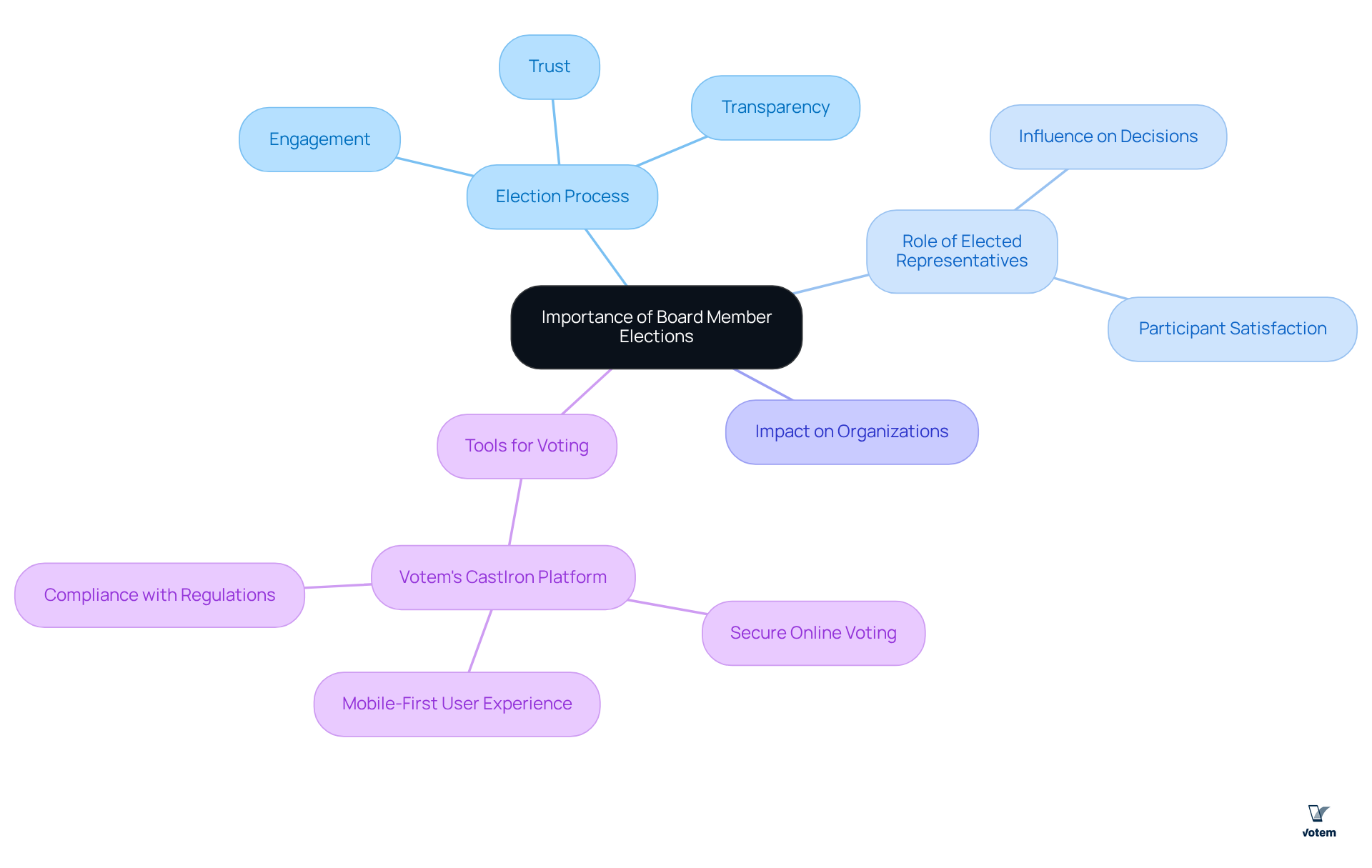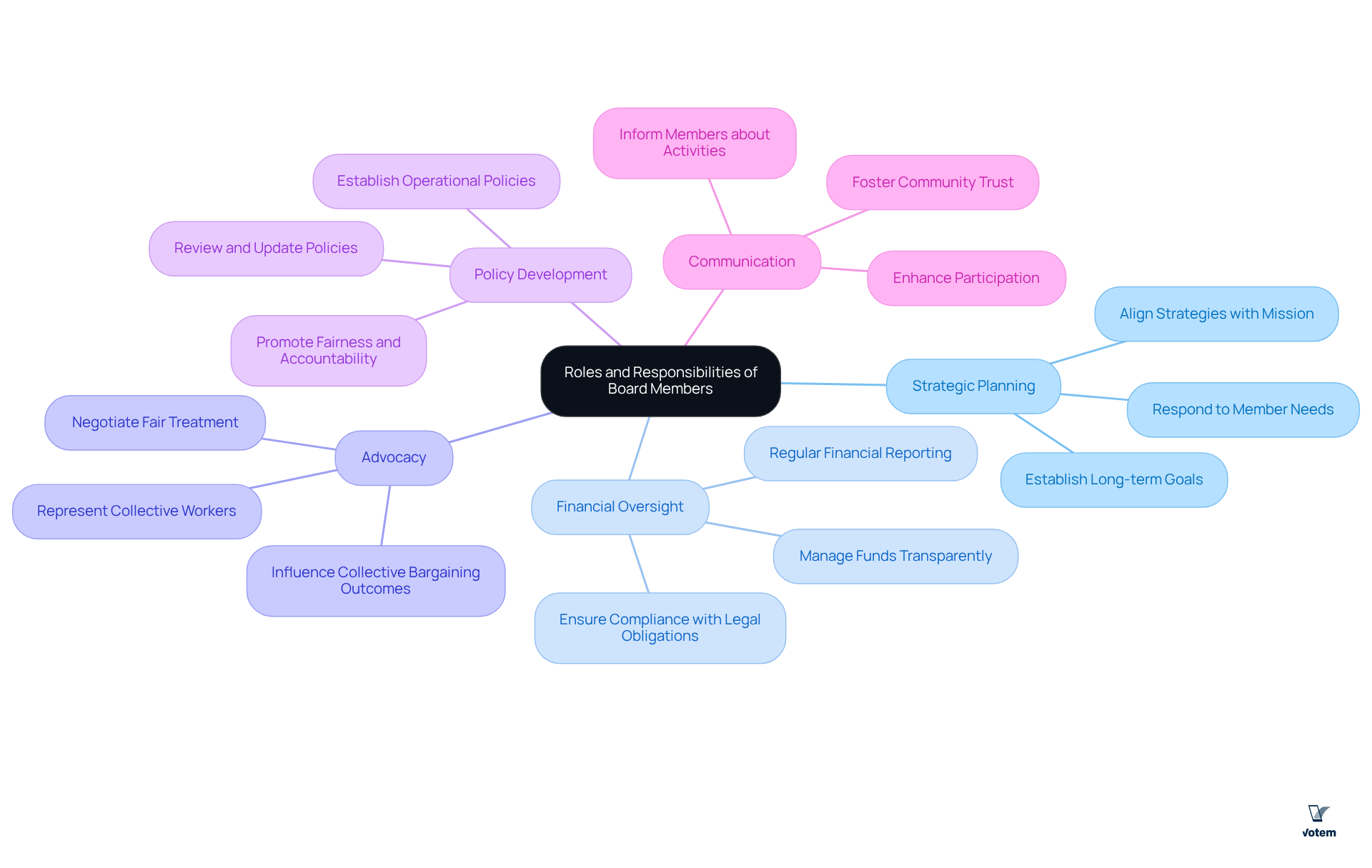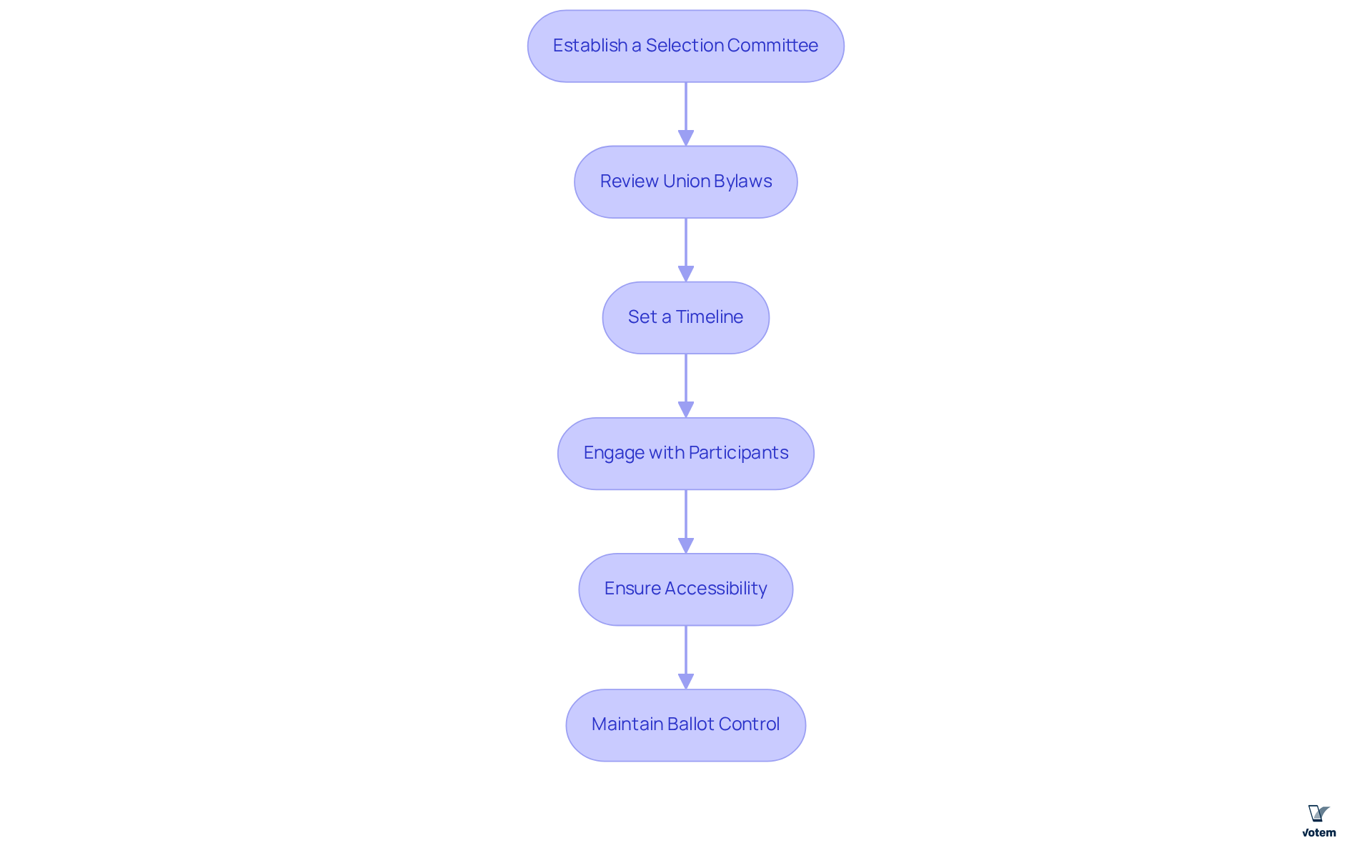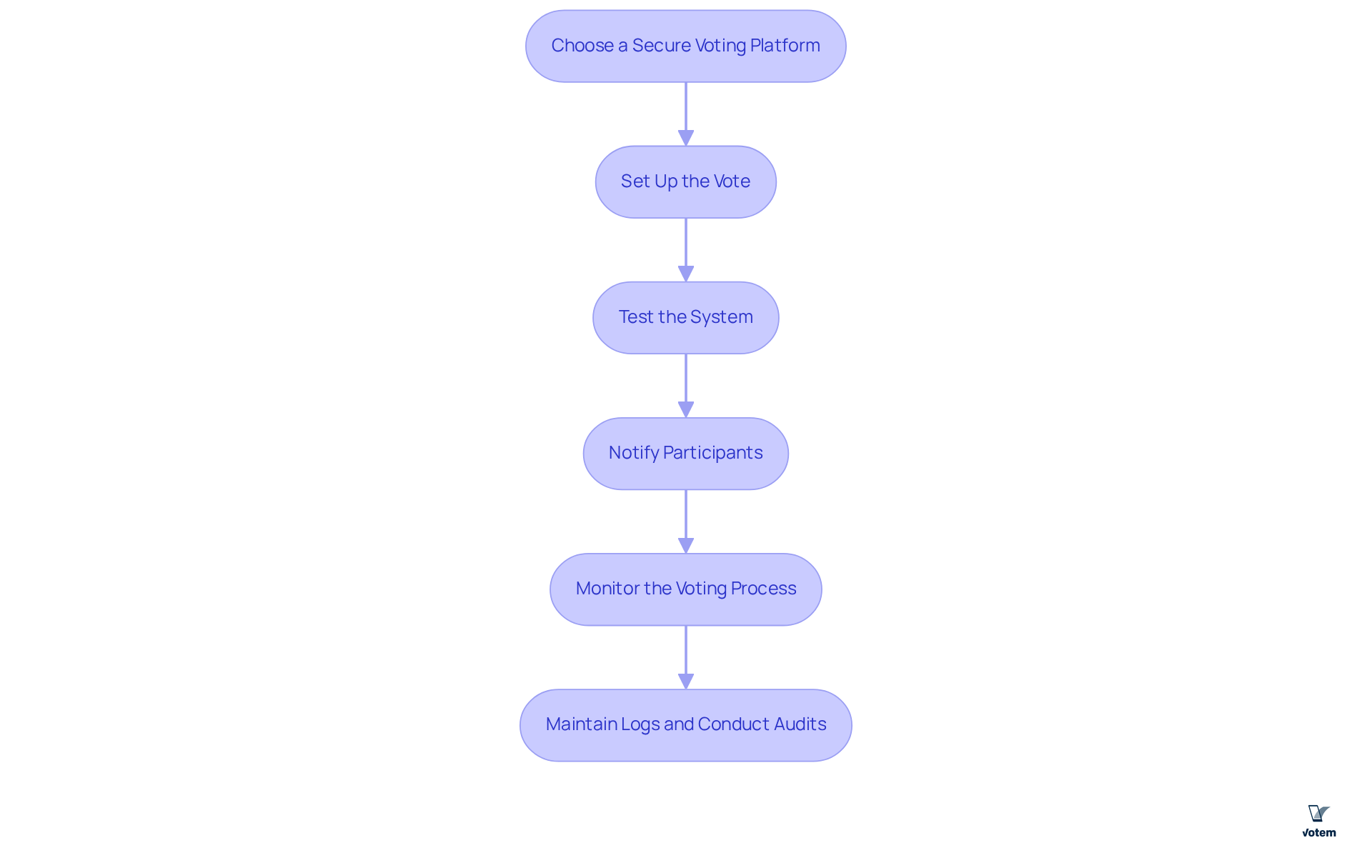Overview
This article presents a comprehensive, step-by-step guide on the election of board members for unions, underscoring the critical need for a transparent and inclusive electoral process. It begins by establishing a selection committee, a foundational step that sets the stage for a fair election.
Furthermore, it emphasizes the utilization of secure online voting platforms, which not only streamline the process but also enhance security and accessibility for all members.
Effective communication is another key aspect discussed, aimed at fostering member engagement and building trust in the election outcomes.
By implementing these strategies, union leadership can significantly improve the electoral experience, ensuring that every voice is heard and valued.
Introduction
Understanding the intricacies of board member elections is crucial for unions, as these elections determine the leaders who will advocate for workers’ rights and shape the organization’s future. With a notable 27% increase in labor organization petitions recently, the call for active participation in these democratic processes has never been more pressing.
However, how can unions ensure that their election processes are not only fair but also engaging and transparent? This guide offers a comprehensive roadmap for unions to navigate the complexities of electing board members, empowering constituents to make informed choices that resonate with their values and aspirations.
Understand the Importance of Board Member Elections
Understanding how to elect board members is critical for organizations, as this process directly influences who advocates for the interests of the constituents. Elected representatives play a pivotal role in shaping decisions that impact working conditions, benefits, and the overall strategic direction of the organization. The recent surge in labor organization petitions, with a notable 27% growth from October 2023 to October 2024, underscores the increasing involvement among labor participants in these democratic activities.
Understanding how to elect board members not only inspires individuals to but also ensures that their voices are heard in selecting representatives who mirror their values and needs. A transparent election process is vital for cultivating trust within the collective and is essential for understanding how to elect board members, reinforcing the democratic principles that underpin labor organizations. For instance, Votem’s CastIron platform has successfully managed over 13 million votes, showcasing its ability to enhance voter turnout and confidence through secure and compliant online voting solutions.
Moreover, the impact of elected representatives extends beyond mere representation; they influence participant satisfaction and the organization’s strategic approach to addressing stakeholder interests. As worker organizations navigate a shifting political landscape, the importance of effective representation becomes increasingly evident. Involving participants in the electoral process is essential for ensuring that their concerns are prioritized and addressed, ultimately leading to a more resilient and responsive organization.

Define Roles and Responsibilities of Board Members
Board members play a pivotal role in the management of an organization, with responsibilities that significantly impact its efficiency and stakeholder satisfaction. Their key roles encompass several crucial areas:
- Strategic Planning: Board members are entrusted with the responsibility of establishing long-term goals and strategies that align with the union’s mission. This ensures that the organization remains focused on its objectives while being .
- Financial Oversight: They hold the critical duty of overseeing the organization’s finances, ensuring that funds are managed transparently and responsibly. This includes regular financial reporting and compliance with legal obligations, which are essential for maintaining stakeholder trust and organizational integrity. The importance of financial oversight is underscored by the requirement for organizations to submit initial information reports and annual financial reports with OLMS, thereby ensuring compliance and accountability.
- Advocacy: Board members serve as representatives of collective workers in negotiations with employers, advocating for fair treatment and improved working conditions. Their effectiveness in this role can directly influence the outcomes of collective bargaining efforts, as demonstrated in recent negotiations where participant engagement proved vital.
- Policy Development: Another critical responsibility involves establishing and reviewing policies that guide the organization’s operations. This ensures that the organization operates within a framework that promotes fairness, accountability, and participant involvement.
- Communication: Keeping individuals informed about organizational activities, decisions, and leadership changes is essential for fostering a sense of community and trust. Effective communication strategies can enhance participation and garner support from individuals.
Understanding how to elect board members is vital for collective participants as they assess candidates during elections. By understanding how to elect board members who are well-prepared to fulfill these responsibilities, associations can fortify their governance and ultimately improve outcomes for all involved. The significance of strategic planning and financial oversight cannot be overstated; these elements are fundamental to successful governance frameworks in organizations, ensuring that decisions made by board members positively shape the organization’s future. Furthermore, utilizing secure online voting systems, such as Votem’s CastIron platform, can significantly boost voter participation and ensure adherence to governance standards, thereby enhancing the integrity of the voting process.

Prepare for the Election Process
To effectively prepare for the election process, unions must adhere to these essential steps:
- Establish a Selection Committee: Form a dedicated group tasked with supervising the ballot process. This committee is crucial for ensuring fairness and transparency—elements vital for maintaining member trust.
- Review Union Bylaws: Thoroughly familiarize yourself with the union’s bylaws concerning voting procedures. Understanding eligibility criteria and nomination processes is essential for a compliant voting system.
- Set a Timeline: Develop a comprehensive timeline for the voting process. This should encompass nomination periods, voting dates, and the announcement of results, ensuring all participants are aware of key dates.
- Engage with Participants: Actively update all participants about the forthcoming vote. Clear communication regarding how they can participate and the significance of their vote is essential for fostering engagement.
- Ensure Accessibility: Implement measures to guarantee that all members can participate in the voting process. This includes accommodating those who may need assistance or alternative voting methods, thereby enhancing overall turnout. Ensure that your voting system complies with WCAG 2.1 AA accessibility standards to promote inclusivity.
- Maintain Ballot Control: Ensure that voting officials retain physical control of all ballots throughout the voting period, including spoiled ballots, which must be accounted for at the conclusion of the ballot tally.
By adhering to these preparatory steps, unions can establish a streamlined voting process that not only teaches members how to elect board members but also encourages their involvement and maintains the integrity of the electoral system. Notably, organizations utilizing Votem’s have seen voter participation rise by as much as three times on launch day, and Votem has effectively overseen over 13 million votes, underscoring the impact of efficient management. Additionally, be aware of the new NLRB rules set to take effect on December 26, 2023, which may influence your voting preparations.

Conduct the Election Using Secure Online Voting
To conduct an election using secure online voting, it is imperative to follow these essential steps:
- Choose a Secure Voting Platform: Begin by selecting a platform that adheres to stringent security standards, including NCUA, DOL, ERISA, and SOC 2 requirements. It should also be user-friendly for all members. Votem’s exemplifies a solution that ensures compliance with regulations while prioritizing security and accessibility.
- Set Up the Vote: Next, configure the voting parameters, including candidate listings, voting periods, and specific rules as outlined in the union’s bylaws. This arrangement is crucial for preserving order and clarity in understanding how to elect board members throughout the voting process.
- Test the System: Conduct a thorough test run of the voting system to identify and resolve any potential issues before the actual voting event. This proactive measure is essential to ensure a smooth voting experience for all participants.
- Notify Participants: Communicate with all individuals by sending out detailed notifications that include instructions on how to vote, links to the voting platform, and important deadlines. Clear communication is vital for maximizing participation in discussions about how to elect board members.
- Monitor the voting process by ensuring that the committee actively oversees how to elect board members to address any issues that may arise and uphold transparency. This oversight cultivates confidence among participants and strengthens the integrity of the voting process.
In addition, maintaining detailed logs of transactions and conducting periodic audits by independent parties are essential to ensure compliance with security policies. The platform should also implement safeguards to ensure ballot secrecy and provide alternative voting methods for individuals without internet access. By utilizing secure online voting, unions can greatly improve participation rates and simplify the voting methods, making it more convenient for members to engage in their democratic rights.

Manage Election Results and Ensure Transparency
To effectively manage election results and ensure transparency, it is imperative to follow these essential steps:
- Tally Votes: Utilize the voting platform‘s integrated tools to accurately count the votes and generate results. This ensures precision in the electoral process, a fundamental aspect of maintaining integrity.
- Verify Results: The committee must independently . This step is crucial for ensuring accuracy and resolving any discrepancies that may arise.
- Announce Results: Promptly convey the voting outcomes to all participants. Detail the chosen candidates and voter turnout statistics to uphold transparency and foster trust.
- Grant Access to Documents: Ensure that voting records are readily available for participant review. This practice promotes transparency and establishes confidence in the voting system.
- Request Input: Following the vote, actively collect opinions from participants regarding the voting procedure. This feedback is vital for identifying areas for enhancement in upcoming votes.
By emphasizing openness in handling voting outcomes, organizations can significantly enhance trust and involvement among their constituents. Each step plays a crucial role in fostering an environment where members feel informed and engaged, ultimately leading to increased participation in future electoral processes. Transparent practices are essential for reinforcing the importance of clear communication and accessibility in union elections.

Conclusion
Understanding the process of electing board members is essential for unions aiming to represent their constituents effectively. This guide emphasizes the importance of a transparent and engaging electoral process, which not only empowers members but also ensures that their voices are reflected in the leadership. The role of board members extends beyond mere representation; they are crucial in shaping the organization’s strategic direction, advocating for fair treatment, and maintaining financial integrity.
Key steps in the election process are outlined:
- Preparing for the election by forming a selection committee.
- Reviewing bylaws.
- Conducting the election using secure online platforms that enhance participation.
- Managing the election results with transparency.
Furthermore, each phase of the process reinforces the significance of member involvement and the impact of effective governance on organizational success.
Ultimately, the strength of a union lies in its ability to engage members in the electoral process, ensuring that their concerns are prioritized and addressed. By following the outlined steps and embracing secure voting practices, unions can foster a culture of participation and accountability. This not only enhances the democratic process but also solidifies the foundation for a more resilient and responsive organization. Engaging in board member elections is not just a procedural necessity; it is a powerful opportunity for members to influence their collective future.
Frequently Asked Questions
Why is understanding the importance of board member elections critical for organizations?
Understanding how to elect board members is essential because it influences who advocates for the interests of constituents, shaping decisions that impact working conditions, benefits, and the overall strategic direction of the organization.
What recent trend highlights the growing involvement of labor participants in board member elections?
There has been a notable 27% growth in labor organization petitions from October 2023 to October 2024, indicating increasing participation in democratic activities.
How does a transparent election process benefit organizations?
A transparent election process cultivates trust within the collective and reinforces democratic principles, ensuring that individuals feel their voices are heard in selecting representatives who reflect their values and needs.
What role do elected representatives play in organizations?
Elected representatives influence participant satisfaction and the organization’s strategic approach to addressing stakeholder interests, making effective representation crucial as organizations navigate a changing political landscape.
What are the key roles and responsibilities of board members?
Board members are responsible for strategic planning, financial oversight, advocacy, policy development, and communication, all of which significantly impact organizational efficiency and stakeholder satisfaction.
How do board members contribute to strategic planning?
Board members establish long-term goals and strategies that align with the organization’s mission, ensuring responsiveness to member needs.
What is involved in the financial oversight responsibilities of board members?
Board members oversee the organization’s finances, ensuring transparency and compliance with legal obligations, which is essential for maintaining stakeholder trust and organizational integrity.
In what way do board members serve as advocates?
They represent collective workers in negotiations with employers, advocating for fair treatment and improved working conditions, which can influence the outcomes of collective bargaining efforts.
Why is communication important for board members?
Effective communication keeps individuals informed about organizational activities and decisions, fostering a sense of community and trust, and enhancing participation and support.
How can organizations improve the election process for board members?
Organizations can utilize secure online voting systems, such as Votem’s CastIron platform, to boost voter participation and ensure adherence to governance standards, enhancing the integrity of the voting process.
List of Sources
- Understand the Importance of Board Member Elections
- NLRB reports union election petitions up 27% from prior year (https://spectrumlocalnews.com/nys/central-ny/news/2024/10/18/nlrb-reports-union-election-petitions-up-27-percent-from-prior-year)
- Labor Board Issues New Election Rules and Makes It Easier for Workers to Unionize Without a Vote – Jackson Lewis (https://jacksonlewis.com/insights/labor-board-issues-new-election-rules-and-makes-it-easier-workers-unionize-without-vote)
- With Unionization Efforts on the Rise, NLRB Tightens Scrutiny on Employer Statements During Union Elections | CDF Labor Law LLP (https://callaborlaw.com/blog/with-unionization-efforts-on-the-rise-nlrb-tightens-scrutiny-on-employer-statements-during-union-elections)
- nlrb.gov (https://nlrb.gov/news-outreach/news-story/national-labor-relations-board-issues-final-rule-to-restore-fair-and)
- Define Roles and Responsibilities of Board Members
- Roles and Responsibilities of Union Leaders in HPWO Partnerships – IAM Union (https://goiam.org/uncategorized/roles-and-responsibilities-of-union-leaders-in-hpwo-partnerships)
- Description of Local Union Officer Duties and Expectations | Columbia Postdoctoral Workers (https://columbiapostdocunion.org/about-us/meet-the-officers/officer-duties-and-expectations)
- AFT1493 | Union Handbook (job duties) (https://aft1493.org/union-handbook-job-duties)
- UE Local Officers Positions and Responsibilities (https://locals.ueunion.org/ue228/ue-local-officers-positions-and-responsibilities)
- Member Rights & Officer Responsibilities (https://afge.org/member-rights-officer-responsibilities)
- Prepare for the Election Process
- Conducting Local Union Officer Elections (https://dol.gov/agencies/olms/compliance-assistance/publications/guide-for-conducting-local-union-officer-elections)
- Checklist for Conducting Local Union Officer Elections (https://dol.gov/agencies/olms/compliance-assistance/elections/checklist)
- Labor Board Issues New Election Rules and Makes It Easier for Workers to Unionize Without a Vote – Jackson Lewis (https://jacksonlewis.com/insights/labor-board-issues-new-election-rules-and-makes-it-easier-workers-unionize-without-vote)
- fosterswift.com (https://fosterswift.com/newsroom/publications/new-nlrb-rule-speeds-union-election-process)
- Conduct the Election Using Secure Online Voting
- Electing Union Officers Using Remote Electronic Voting Systems (https://dol.gov/agencies/olms/compliance-assistance/tips/remote-electronic-voting-systems)
- abc.org (https://abc.org/News-Media/Newsline/new-cdw-report-criticizes-electronic-voting-in-union-elections)
- NLRB Seeks Input on Electronic and Internet Voting for Union Recognition Elections | Littler (https://littler.com/news-analysis/asap/nlrb-seeks-input-electronic-and-internet-voting-union-recognition-elections)
- DLT Resolution and Union Strategies Launch Vote YourChoice – Secure Online and Remote Voting Platform (https://apnews.com/article/technology-business-voting-hacking-telecommunications-f8662a9e96024cba7e06aa172ee7b0ac)
- Manage Election Results and Ensure Transparency
- quarles.com (https://quarles.com/newsroom/publications/the-union-election-is-done-what-are-the-next-steps)
- epi.org (https://epi.org/publication/improve-transparency)
- Improving Trade Union Election Transparency – ElectionBuddy (https://electionbuddy.com/blog/2024/06/24/improving-trade-union-election-transparency)
- After the Win: What Happens After a Successful Union Election? (https://uniontrack.com/blog/successful-union-election)
- Employees at Sesame Workshop Win Union Election Joining OPEIU Local 153 — OPEIU Local 153 (https://opeiulocal153.org/news/employees-at-sesame-workshop-win-union-election-joining-opeiu-local-153)

